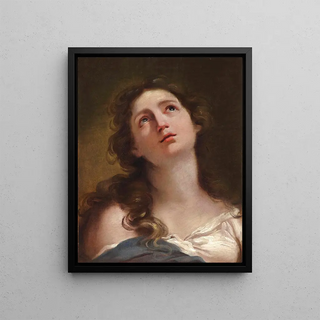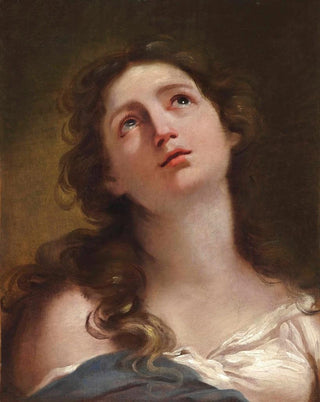Art print | Head of a young woman - Gaetano Gandolfi


View from behind

Frame (optional)
Gaetano Gandolfi's "Head of a Young Woman" is a true jewel of 18th-century Italian painting. This artwork, imbued with delicacy and sensitivity, evokes the timeless beauty of female portraits from that era. Through its gaze, the artist manages to capture not only the physical appearance of the model but also an essence, an emotion that transcends time. Gandolfi's art, at the crossroads between baroque and neoclassicism, invites us to immerse ourselves in a universe where beauty is elevated by technique and fine detail. The art print of this piece allows for a rediscovery of its depth, offering a direct connection to the creative spirit of the artist.
Style and uniqueness of the artwork
The "Head of a Young Woman" stands out for its elegant style and mastery of nuances. The face, delicately modeled, features harmonious and expressive traits, while the play of light creates an almost tangible atmosphere. Subtly placed shadows accentuate the softness of the contours, bringing this portrait to life. Gandolfi excels in the use of color, favoring soft tones that evoke tenderness and serenity. The meticulous details, whether in the depiction of hair or clothing, testify to diligent work and a passion for perfection. Every element of the composition contributes to an overall harmony, making the work not only visually appealing but also emotionally resonant.
The artist and his influence
Gaetano Gandolfi, born in Bologna, established himself as one of the masters of portraiture of his time. Trained in a rich artistic environment, he was influenced by the great names of Italian painting, while developing a personal style that is uniquely his own. His work is marked by a unique sensitivity, highlighting female beauty in all its forms. Gandolfi also contributed to the transition between flamboyant baroque and neoclassicism, integrating elements of both movements into his work. This duality is reflected in the "Head of a Young Woman," where the sensuality of baroque lines

Matte finish

View from behind

Frame (optional)
Gaetano Gandolfi's "Head of a Young Woman" is a true jewel of 18th-century Italian painting. This artwork, imbued with delicacy and sensitivity, evokes the timeless beauty of female portraits from that era. Through its gaze, the artist manages to capture not only the physical appearance of the model but also an essence, an emotion that transcends time. Gandolfi's art, at the crossroads between baroque and neoclassicism, invites us to immerse ourselves in a universe where beauty is elevated by technique and fine detail. The art print of this piece allows for a rediscovery of its depth, offering a direct connection to the creative spirit of the artist.
Style and uniqueness of the artwork
The "Head of a Young Woman" stands out for its elegant style and mastery of nuances. The face, delicately modeled, features harmonious and expressive traits, while the play of light creates an almost tangible atmosphere. Subtly placed shadows accentuate the softness of the contours, bringing this portrait to life. Gandolfi excels in the use of color, favoring soft tones that evoke tenderness and serenity. The meticulous details, whether in the depiction of hair or clothing, testify to diligent work and a passion for perfection. Every element of the composition contributes to an overall harmony, making the work not only visually appealing but also emotionally resonant.
The artist and his influence
Gaetano Gandolfi, born in Bologna, established himself as one of the masters of portraiture of his time. Trained in a rich artistic environment, he was influenced by the great names of Italian painting, while developing a personal style that is uniquely his own. His work is marked by a unique sensitivity, highlighting female beauty in all its forms. Gandolfi also contributed to the transition between flamboyant baroque and neoclassicism, integrating elements of both movements into his work. This duality is reflected in the "Head of a Young Woman," where the sensuality of baroque lines






